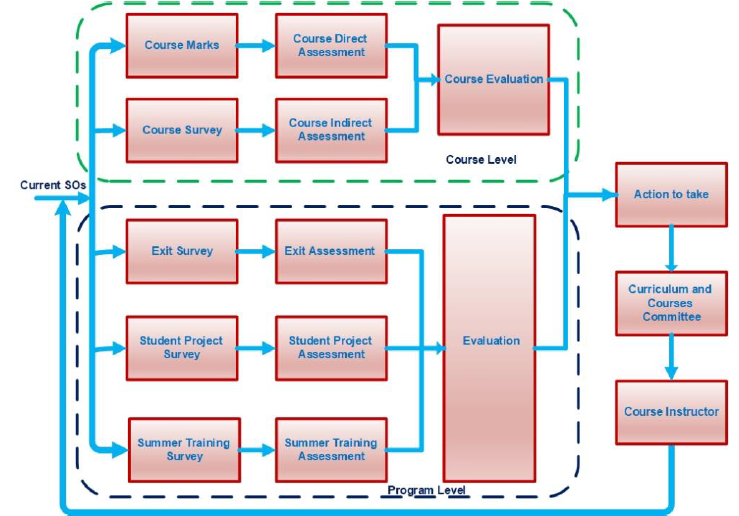
Student outcomes are assessed and evaluated annually using an a priori assessment and evaluation process.
This annual cycle culminates in an all-day ABET Retreat in which department faculty conduct a comprehensive
review of all assessment data and
i) determine whether student outcomes are being attained,
ii) determine the effectiveness of continuous improvement initiatives,
and iii) formulate continuous improvement action items needed to address assessment results and/or further improve
student outcomes.
Additionally, program educational objectives and the department mission statement are reviewed and may be modified
based on discussion and consensus.
All full-time departmental faculty participate in the annual assessment and evaluation process through active
participation in the ABET Retreat and by serving on one of three working committees:

Direct Assessment
The direct assessment of the outcomes usually relies on the coursework and uses a variety of tools that
include combinations (as defined in the articulation matrix at the beginning of academic year) of final exam,
midterm tests, quizzes, homework, laboratory works, assignments, practical, projects, presentations, etc.
The assessment tools do however vary from course to course.
Indirect Assessment
Our indirect assessment involves conducting a variety of surveys. Upon completion of each course, a student survey is
administered to gather feedback. Faculty members facilitate formal written surveys that specifically address the intended outcomes and collect
responses from students who have finished their CEE courses. These surveys are conducted during class sessions and ABET retreat sessions.
Furthermore, exit and industrial board surveys are periodically conducted at the end of each academic year to assess program eligibility.
The indirect assessment is carried out every semester to ensure consistent evaluation.
To prepare for the assessment and evaluation of our courses and program, the entire program faculty engaged in several brainstorming meetings.
These sessions focused on discussing various aspects related to seeking accreditation. The issues addressed in these meetings encompassed the
following topics, among others:
The CEE program uses different tools and processes to assess and evaluate the extent to which its SOs are
being attained. These processes are used to gather the data which is necessary for the assessments.
Evaluation, in the form of interpreting the data, is then carried out in order to determine how well the
outcomes are being attained. The results of both the assessment and evaluation processes are finally utilized
for the continuous improvement of the program. The steps used for the assessment, evaluation and feedback to
the continuous improvement of the program follow the following three steps:
1. Assessment tools of the SOs (i.e., collecting data) can be direct or indirect. Direct assessment of SOs
usually relies on the course work, whereas indirect assessments of SOs are usually obtained by using surveys.
This step includes designing forms of surveys and appropriate questions for the specific and applicable data.
2. The collected data is analyzed and compared to a pre-set performance indicator, which constitutes the
evaluation processes.
3. Checking the degree to which the data evaluation results meet the pre-set targets will be the force for
the continuous improvement processes.